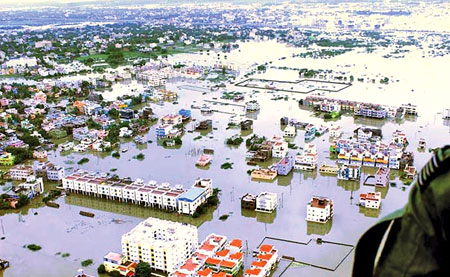|
Chennai post floods:
A city of deluge, disease and desolation
by S. Gopikrishna Warrier
Even though there is respite from rain and threat of renewed
flooding, the spread of communicable diseases looms large over Chennai.
Already, cases of vomiting and gastroenteritis are being reported. Soon,
the usual monsoon diseases like cholera, dengue, leptospirosis that
plague the city every year might follow.
 |
|
- NDTV |
Is Chennai waiting for its `Surat moment’ to get its act together? It
seems the city has come dangerously close to the situation that Surat –,
the diamond capital of India – faced when hit by a plague in 1994. The
pneumonic plague incident, which cost the lives of 52 and led to the
migration of 150,000 people, caused a major health scare across the
country.
Swathes of water
Chennai over the past month has been covered in vast swathes of water
with garbage floating on it. Sewage has entered storm water channels,
clogging them. Blocked with water hyacinth and overgrown with sewage,
the Cooum and Adyar rivers and the Buckingham Canal could barely carry
flood water when the sluice gates at Chembarambakkam were opened.
The rivers soon flooded the areas adjoining their banks. As the water
level subsides, the waste left by the flood is strewn on the roads.
Since the city has a flat terrain, it, naturally, has poor drainage. The
mouths of its rivers are clogged with sand and construction along the
banks has narrowed the rivers and reduced the flow.
The unsegregated garbage adds to the problem in inundated areas.
Corporation of Chennai estimates the city generates 4,500 tonnes of
garbage daily. This is deposited in plastic bags and left in bins at
each street corner and picked up by collection trucks and deposited at
landfills in Kodungaiyur in north Chennai and Perungudi in the south.
Chennai seems unaware of its own filth. It seems to have got
comfortable with it. Sadly, in extended areas where roads and sewerage
lines were recently laid, officials have overlooked precautionary
measures to manage solid waste.
The Koyambedu Market Complex is a case in point. Promoted as the
largest such facility in Asia, it handles tonnes of fruits, vegetables
and flowers everyday but does not have a system for disposal of waste. A
biomethanation plant to generate electricity from waste was set up in
2006. It worked in fits and starts but is now in disuse. Similarly, a
proposal to turn non-biodegradable waste into electricity is yet to get
clearance.
The citizens and administrators of Chennai do not have control over
rain. But they can certainly control the way they manage and live in the
city, so that the floods do not also result in an avoidable health
tragedy. Chennai should stop waiting for its Surat moment.
(The author is an environment journalist and blogger)
- Times of India |

